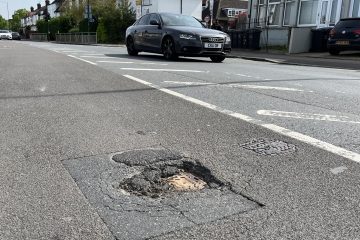In the last quarter of 2023, the RAC attended nearly a quarter more breakdowns where potholes were likely to blame, compared to Q2.
To mark National Pothole day, which took place on 15th January, the breakdown organisation said that roadside staff went to an average of 20 breakdowns a day between October and the end of the year, a total of more than 1,800, where potholes played a part, a 23% increase on the previous three months.
Faults included damaged shock absorbers, broken suspension springs and distorted wheels. This figure was up from 16 a day, or 1,462 in total, in the July-August timeframe, and was the highest number of pothole-related breakdowns seen in the fourth quarter since 2019.
National Pothole Day more relavent than ever
National Pothole Day was established in 2015 to help highlight the plight of potholes and the damage they cause. The topic is one of constant frustration, with many drivers believing road surface repairs should be completed quicker, with potholes opening up seemingly more frequently than ever.
With cold and wet weather in recent weeks, more people have become aware of National Pothole Day as an opportunity to raise awarenesses of the poor state of roads around the country.
The RAC says the threat of a plethora of potholes appearing over the next few months is now very real indeed given how much rain there has been either side of December’s sub-zero temperatures. These are the perfect conditions for creating potholes, as water makes its way into cracks which then expand when it freezes, causing the road surface to crumble, making National Pothole Day more relevant than ever.
“The wet weather we have had both before and after the coldest start to winter in 12 years in December is the perfect recipe for potholes to start peppering the roads,” said RAC head of roads policy Nicholas Lyes, in the release to mark National Pothole Day.
“We fear that by the Spring, drivers will be plagued by a plethora of potholes across the country’s roads which makes journeys uncomfortable and frustrating or, worse still, could lead to very expensive garage repair bills – the last thing anyone wants in a cost-of-living crisis. It is also important to remember that potholes are so much more than just an annoyance, they are a true road safety danger, especially for those on two wheels as they represent a huge risk to their personal safety.
“As many drivers will no doubt testify, there are too many occasions where potholes have been poorly patched up by cash-strapped councils which then return all too quickly. It is frankly absurd that, as a country, we seem unable to get on top of such an age-old problem when roads play such an important role in people’s everyday lives – and are vital to moving goods and businesses delivering services.
An increase in the number of potholes will likely mean more wheel alignment work coming into garages. This makes the time around National Pothole Day a good time to invest in wheel alignment equipment.
More roads starting to crumble
In the later part of last year, statistics released by the Department for Transport (DfT) showed that a third of local ‘B’ and ‘C’ roads in the UK are in poor condition, while over a quarter of ‘A’ roads are also in need of maintenance.
The figures showed that 6% of B and C roads, and 4% of A roads, are classified red, meaning they are in urgent need of repair. For the more rural roads, this figure has remained constant since March 2015, highlighting that more needs to be done to ensure repairs are carried out as soon as possible. The number of A roads classified red has remained the same as 2021, although the figure has increased compared to 2020.
With the freezing conditions in December, these numbers could increase, with a large number of potholes already appearing on local and national roads, meaning this year’s National Pothole Day was a strong opportunity to highlight the issues.
Research for the RAC’s latest Report on Motoring found that an enormous 86% of drivers have had to deliberately steer to avoid potholes over the past year, a figure that rises to 90% of those in rural areas but only falls to 81% of those in urban locations. Most drivers (55%) also rated pothole repairs in their local areas as ‘poor’ or ‘very poor’.
“Councils are crying out for more funding to do a proper job in getting their roads up to a decent standard,” added Lyle. “With drivers still rating the ongoing poor state of the roads as one of their biggest motoring frustrations.”



